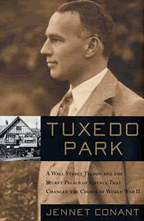| |
| |
|||
| Posted on Sun, Jul. 21, 2002 | |||
The scientist-tycoon
whose work on radar helped win WWII
Tuxedo Park An eccentric, fabulously wealthy scientist performs groundbreaking experiments on the nature of time in his stone castle and, after hosting a sumptuous feast for his colleagues and friends, forces his guests to participate in brain-wave experiments while hypnotized. Something out of H.G. Wells or Mary Shelley? No, a real scene from the life of Alfred Lee Loomis, the extraordinary American financier, scientist, and philanthropist who played a pivotal role in the development of radar and the creation of the Manhattan Project during World War II. Jennet Conant, granddaughter of James B. Conant, the Harvard president who was a colleague of Loomis, has written a fascinating biography of this unusual and impressive figure. Conant had unrestricted access to correspondence between Loomis and her grandfather, as well as to other previously unpublished documents. During World War I, Loomis directed ballistic research at Aberdeen Proving Ground. After the war, he and his brother-in-law developed the idea of holding companies for electric utilities. The two converted most of their holdings to long-term Treasury bonds just before the 1929 stock market crash, and as a result, earned an estimated $50 million during the Depression. Loomis created a laboratory in an old castle-like home in Tuxedo Park, N.J., a walled enclave 40 miles outside New York City that was home to Rockefellers, Morgans, and Vanderbilts. This private laboratory became one of the country's leading facilities for basic science research. During World War II, Loomis chaired a committee charged with developing more accurate radar. He closed the Tuxedo Park lab and built up the MIT Radiation Laboratory. Much has been written about Los Alamos and the atomic bomb, but there have been few popular accounts of the monumental work done by the MIT RAD Lab. Loomis single-handedly turned it into a production facility, with deliveries of 2,000 radar sets per month for military applications. Loomis himself helped in several major advances, including designing the LORAN system for long-range navigation that is still the standard microwave-based navigational tool. Tuxedo Park provides a compelling account of the secrecy, intrigue, failures and successes surrounding the development of radar. Ultimately, Loomis and his laboratory designed and delivered radar systems that could accurately locate enemy aircraft and submarines, and guide Allied bombers in nighttime missions and landings, leading to the ultimate RAD Lab accolade: "Radar won the war; the atom bomb ended it." Loomis was also involved at the beginning of the Manhattan Project, helping to fund Ernest Lawrence's cyclotron project and Enrico Fermi's chain-reaction studies. Loomis' reputation suffered from the scandal of his divorce from his ill wife and subsequent marriage to a close friend's former wife. But, as Conant points out, the scandal is not why Loomis' story has been marginalized. He was one of the last of the "gentleman scientists," averse to bragging. Here was a man rich enough to have owned Hilton Head Island and important enough to count most of the world's leading scientists as colleagues and friends, but reluctant to take any credit for what he had done. Conant has done a notable job in giving him his due. |
|||
|
Richard Di Dio teaches mathematics and computer science at La Salle University. |
|||
